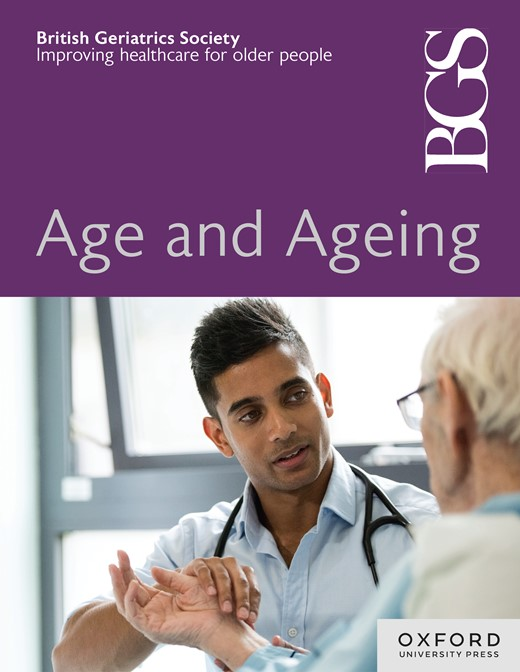3167生活方式和多种药物对社区居住老年人多种疾病进展的影响
IF 6
2区 医学
Q1 GERIATRICS & GERONTOLOGY
引用次数: 0
摘要
在全球范围内,约有三分之一的社区老年人患有复杂的多重疾病。复杂多病(三种或三种以上慢性疾病,影响三种或三种以上不同的身体系统)的结果比多病更差,如更频繁的住院治疗和过早死亡。社会人口学因素在多重疾病进展中的作用已被发现,但生活方式和多重用药的影响尚不清楚。本研究旨在探讨生活方式和多种药物对社区居住老年人多重疾病进展的影响。方法研究使用2017年和2020年中国南方老年人健康检查记录(n = 3647)的数据。结果是3年后老年人的发病率由多发病转变为复杂多发病。采用Logistic回归模型分析生活方式(饮食、体力活动、吸烟和饮酒)和基线多药对多病进展的影响。人口统计变量也作为混杂变量包含在模型中。结果13.5% (n = 491)的老年多病患者发展为复杂多病。复杂多发病比例由32.1%上升至45.6%。logistic回归分析表明,与每天运动的人相比,不运动的人(OR = 1.561, 95%CI: 1.233-1.976, p <;0.001)和偶尔运动的人(OR = 1.670, 95%CI: 1.328-2.100, p <;0.001)更可能有复杂的多重疾病。吸烟者的风险高于非吸烟者(OR = 1.636, 95%CI: 1.137-2.353, p <;0.01)。丧偶者比已婚者更容易发生复杂的多重疾病(OR = 1.532, 95%CI: 1.221-1.923, p <;0.001)。饮食、饮酒和多种药物对多发病的进展无显著影响。结论缺乏运动、吸烟和丧偶可显著增加社区居住老年人多病进展并发展为复杂多病的风险。未来的研究可以集中在开发和实施基于运动的干预措施,以延缓多病的进展。本文章由计算机程序翻译,如有差异,请以英文原文为准。
3167 The impact of lifestyle and polypharmacy on the progression of multimorbidity in community-dwelling older adults
Introduction Globally, about one-third of community-dwelling older adults suffer from complex multimorbidity. Complex multimorbidity (three or more chronic diseases and affecting three or more different body systems) have worse outcomes than multimorbidity, such as more frequent hospitalizations, and premature mortality. The effect of sociodemographic factors in the progression of multimorbidity has been found, but the lifestyle and polypharmacy remain unclear. This study aims to explore impact of lifestyle and polypharmacy on the progression of multimorbidity among community-dwelling older adults. Methods The study used data from the health examination records of older adults residing in Southern China in 2017 and 2020 (n = 3647). The outcome was occurrence of the status of the older adults changed from multimorbidity to complex multimorbidity after 3 years. Logistic regression model was used to analyse the influence of lifestyle (diet, physical activity, smoking and drinking) and polypharmacy of baseline on the progression of multimorbidity. Demographic variables were also included in the model as confounding variables. Results Totally 13.5% (n = 491) of older adults with multimorbidity had developed into complex multimorbidity. The proportion of complex multimorbidity increased from 32.1% to 45.6%. The logistic regression analysis indicated that, compared with who exercise daily, those who don’t exercise (OR = 1.561, 95%CI:1.233–1.976, p < 0.001) and those exercise occasionally (OR = 1.670, 95%CI:1.328–2.100, p < 0.001) are more possibly to have complex multimorbidity. The smokers have a higher risk than non-smokers (OR = 1.636, 95%CI:1.137–2.353, p < 0.01). Those widowed are more likely to developing complex multimorbidity than those married (OR = 1.532, 95%CI:1.221–1.923, p < 0.001). Diet, drinking and polypharmacy had no significant effect on the progression of multimorbidity. Conclusions Lack of exercise, smoking and loss of spouse can significantly increase risk of the progression of multimorbidity and developing into complex multimorbidity among community-dwelling older adults with multimorbidity. Future research could focus on developing and implementing exercise-based interventions to delay the progression of multimorbidity.
求助全文
通过发布文献求助,成功后即可免费获取论文全文。
去求助
来源期刊

Age and ageing
医学-老年医学
CiteScore
9.20
自引率
6.00%
发文量
796
审稿时长
4-8 weeks
期刊介绍:
Age and Ageing is an international journal publishing refereed original articles and commissioned reviews on geriatric medicine and gerontology. Its range includes research on ageing and clinical, epidemiological, and psychological aspects of later life.
 求助内容:
求助内容: 应助结果提醒方式:
应助结果提醒方式:


